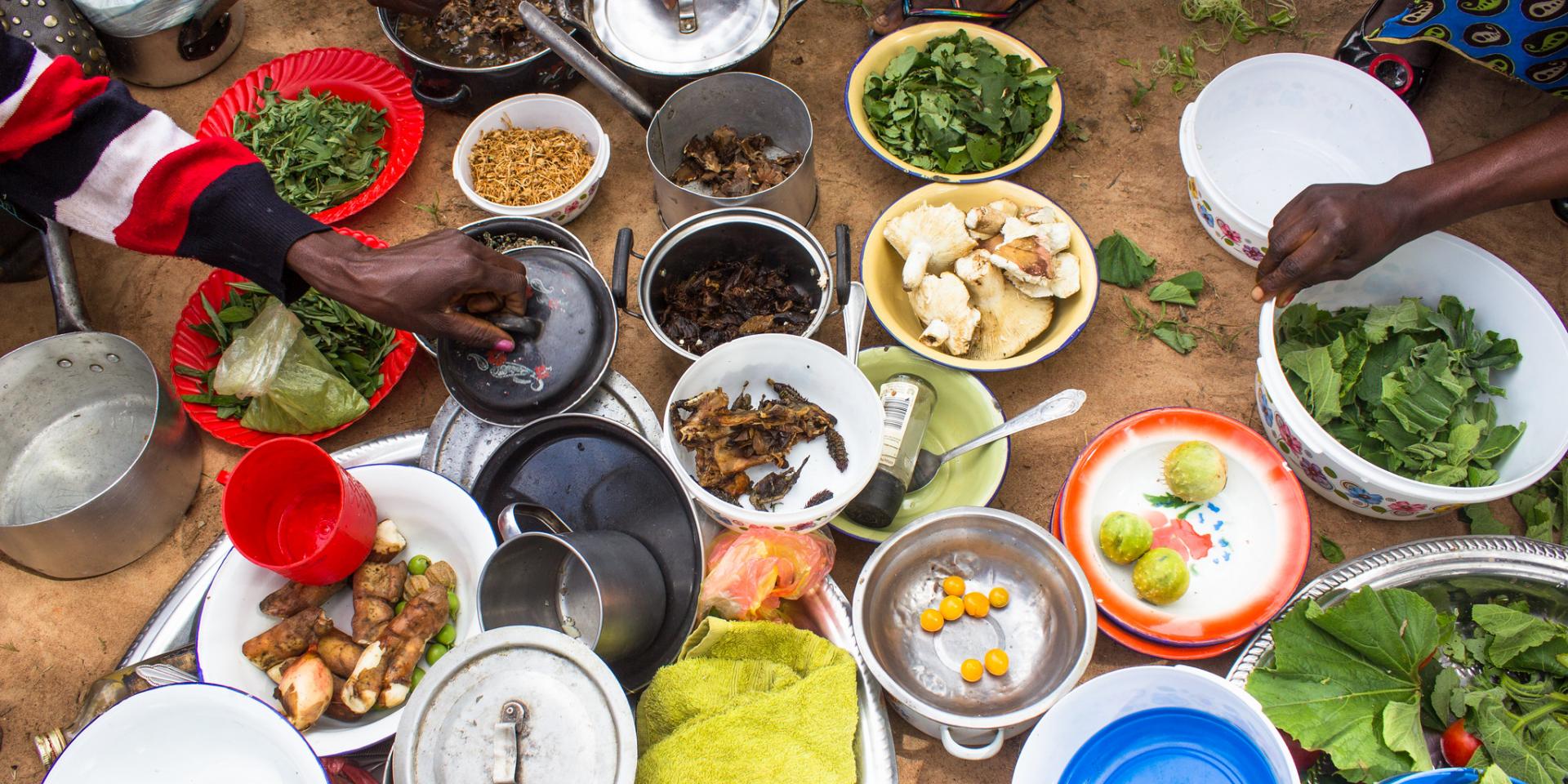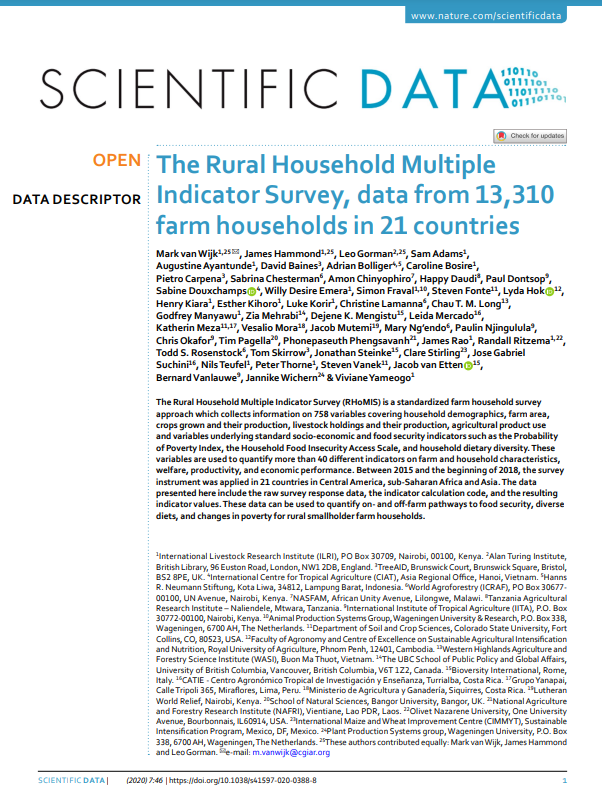More women’s agency on farms relates to better household nutrition—but differs by the type of production system
 Photo: Joe Nkadaani/CIFOR.
Photo: Joe Nkadaani/CIFOR.
Key messages:
- The diets of farm households are closely linked to agricultural production systems, agricultural productivity, farm and nonfarm income, market access, and women’s engagement in household and agricultural activities.
- We investigated how household dietary diversity on farms is related to women’s agency and measure agency by measuring women’s control over consumption of livestock and crops, revenue and farm planning; and women’s ownership of land and livestock ownership.
- Generally, higher women’s agency is associated with higher household dietary diversity and, therefore, better household nutrition. However, this association is influenced by the volume and diversity of farm produce and the use of cash crops and wild foods.
- Policy and programs that aim to increase nutrition should employ such analyses to identify and invest in the areas of women’s agency most likely to have a large impact on household nutrition. Policy and programs that aim to improve women’s empowerment can also improve the efficacy of interventions by prioritizing areas of women’s agency that have such multiplier effects.
Household dietary diversity (HDD) is an important indicator of nutrition and promoting balanced, diverse diets is aligned with the United Nations Sustainable Development Goals of Zero Hunger and Good Health and Well-being.
In the global South, rural agricultural households experience high variance in dietary diversity based on what they grow on their farms, how much they produce, income they earn from nonfarm activities, and their access to markets and other food sources. Dietary diversity is also heavily influenced by women’s agency and decision-making regarding those.
There is increasing evidence on women’s empowerment in agriculture and its impact on household nutrition.
We related household diet diversity, women’s agency, production systems and food availability
Our recent research explores the relationship between HDD and women’s agency over eight factors relevant to farm households. These include women’s control over consumption of livestock and crops; women’s control over crop, livestock, and off-farm revenue; women’s control over farm planning/crops grown; and women’s ownership of land and livestock (where ownership includes both joint and single ownership).
Additionally, we distinguish between food that was sourced from the farm and food that was purchased by the household and analyze dietary diversity across two reference periods: periods of low access to food and periods of high access to food. Hence, we look at four types of HDD: “purchased HDD during the bad month”, “purchased HDD during the good month”, “farm-based HDD during the bad month”, and “farm-based HDD during the good month”.
Finally, we study smallholder farmers across three different cropping and livestock (‘mixed production’) systems present in parts of Burkina Faso, Ethiopia and Zambia. We categorize these systems by key production characteristics:
- Burkina Faso—higher crop and livestock diversity relative to Ethiopia and Zambia
- Ethiopia—higher crop and livestock production volume relative to Burkina Faso and Zambia
- Zambia—higher reliance on cash crops and wild foods relative to Burkina Faso and Ethiopia
Our research uses data from the Rural Household Multi-Indicator Survey (RHoMIS) dataset. The RHoMIS dataset is a novel standardized farm household survey that assesses 40 different indicators and makes a comparative analysis possible. The selected datasets are three datasets within the RHoMIS dataset and consist of household data from randomly selected households from several subregions in the three countries.
Higher agency for women relates to better household dietary diversity
Overall, we find that:
- When levels of women’s agency are higher, HDD is also higher. Specifically, during periods of low food access, the number of food types consumed from the farm is higher when women have more agency. And during periods of high food access, the number of food types purchased for consumption is higher when women have more agency.
- The areas of women’s agency which relate to higher HDD are different across the three production systems studied. Therefore, different areas of women’s agency matter more or less depending on production system characteristics and baseline poverty levels.
- In general, a stronger relationship between women’s agency and HDD are observed in Burkina Faso and Ethiopia. This suggests that women’s agency is more strongly linked with HDD when the volume of farm produce is high or when the diversity of farm produce is high. However, a weaker relationship between women’s agency and HDD is observed in Zambia, suggesting that the relationship is weaker when households are poorer and when households rely on cash crops and wild foods.
Investing in most effective areas of women’s agency can boost policy and program benefits
These results have important implications for food- and nutrition-focused policy. Our results suggest that policy and program design should leverage the relationship between women’s agency and dietary diversity when designing nutrition-focused programs.
For example, nutrition-focused programs can improve program outcomes by identifying which dimension of women’s agency (e.g. control over different revenue streams vis-a-vis ownership of land or ownership of livestock) is more likely to result in improved household nutrition. Following this, they can assume a more targeted approach and prioritize dimensions of women’s agency that are most likely to have a larger impact on household diets.
Our results also have implications for women-empowerment programs: investing in certain dimensions of women’s agency (e.g. improving women’s ownership of livestock) can improve secondary outcomes or have multiplying effects which investing in another dimension of women’s agency (e.g. increasing women’s control over off-farm revenue) might not.
We suggest that additional comparative analyses across production systems based on more rigorous techniques are required in order to improve program outcomes and efficiency. Such analyses could improve programs by:
- encouraging investments in the dimension of women’s empowerment that matter most for household dietary diversity
- identifying pathways (e.g., farm-based versus purchased food) through which nutrition outcomes could best be realized
- customizing interventions based on local characteristics of production systems
Our research demonstrates the potential of standardized survey instruments to aid such contextualized, comparative analysis that will inform and aid policy efforts.
References
Agriculture and nutrition in India: mapping evidence to pathways
Nutrition-sensitive interventions and programmes

The Rural Household Multiple Indicator Survey, data from 13,310 farm households in 21 countries.
van Wijk, M., Hammond, J., Gorman, L., Adams, S., Ayantunde, A., Baines, D., ... and Yameogo, V. 2020. “The Rural Household Multiple Indicator Survey, data from 13,310 farm households in 21 countries.” Scientific Data 7(1): 46.